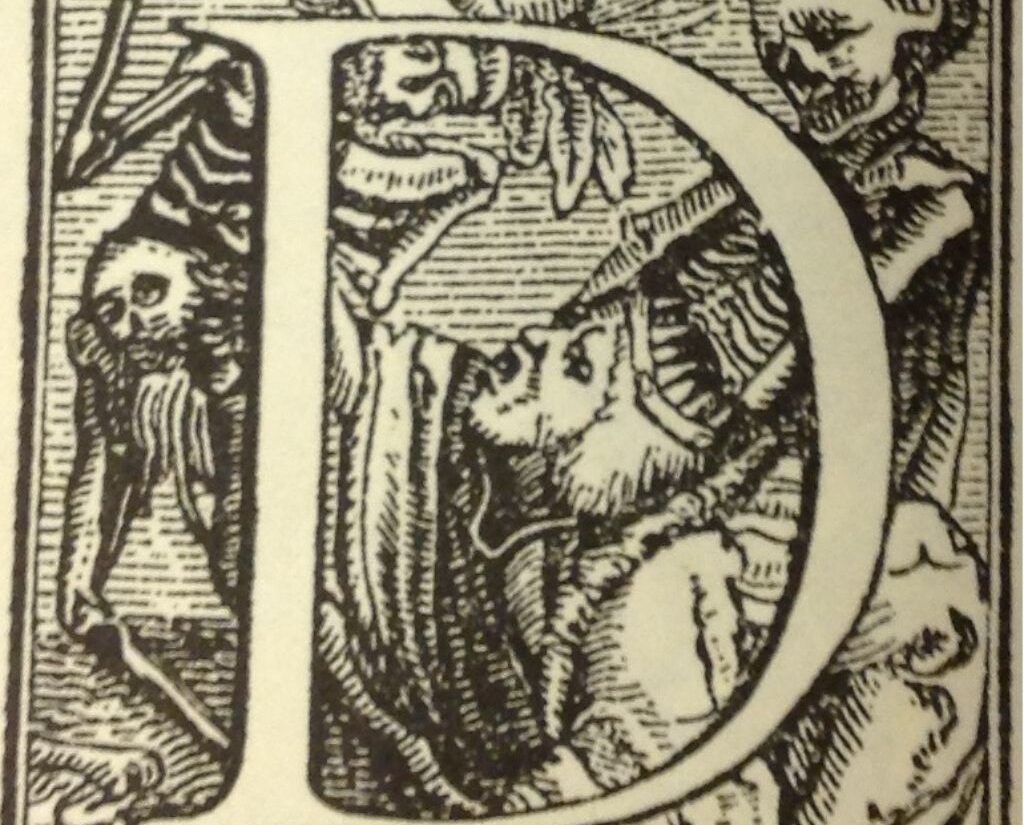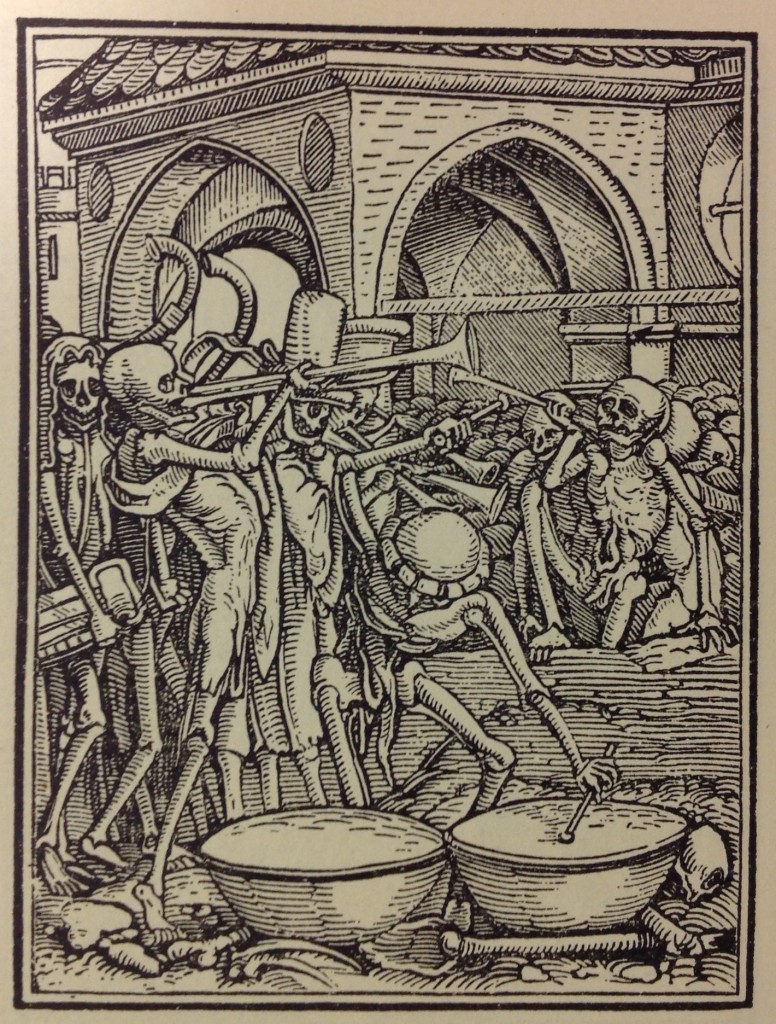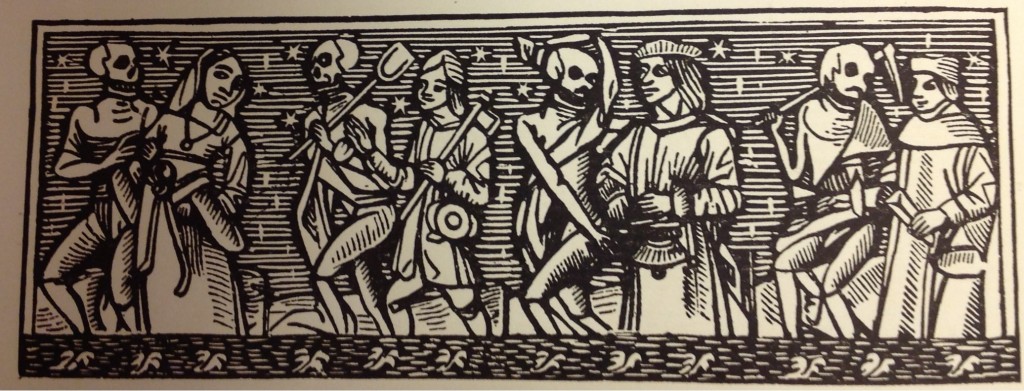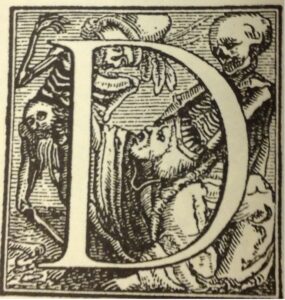It’s Time for Hallowe’en and The Dance of Death
- Elaine Harrington
- October 30, 2013

Should Hallowe’en remind us of costumes, chocolate and bobbing for apples? Perhaps it is an event that reminds us of the passing of time and how death comes for us all. A cheery thought indeed and one that is realised by ‘The Dance of Death.’
‘The Dance of Death’ or ‘Danse Macabre’
‘The Dance of Death’ is known by many names including: ‘Danse Macabre’ and ‘Danse des Morts’ (French), and ‘Totentanz’ (German). ‘The Dance of Death’ is an allegorical representation of the universality of death. Death haunts all souls be they rich or poor, young or old, pious or sinners. ‘The Dance of Death’ reminds all of the fleetingness of human lives and how vain are earthly delights. There are three elements to the dance: an element of satire as all men are equal, the confronting of the living with the dead, and the dance itself. The Black Death with its horrors from the mid-14th century may have familiarized people with the macabre aspect.
Representations of this dance have been found in murals, paintings, woodcuts and music. In 1538 Hans Holbein the Younger published a series of woodcuts illustrating this dance although his designs had originally been created some years earlier. By 1562 eleven editions had been printed. To date over 100 editions have been published. Natalie Zemon Davis writes that “Holbein’s pictures are independent dramas in which Death comes upon his victim in the midst of the latter’s own surroundings and activities” (101).
UCC Library’s Special Collections has important collections of rare books, manuscript material, ephemera, photographs and works of art. Two such collections are the Humour Collection and the Bax Collection. Special Collections is located in the Q-1 floor of the Boole Library.
UCC Library’s Special Collections holds the series of the Early English Text Society (TR 828 EETS). ‘The Dance of Death‘ is produced in volume 181. According to White’s introduction in the EETS volume there are twelve manuscripts of the English version of the ‘Danse Macabre’ of which Mss. Ellesmere 26/A.13 and B.M. Lansdowne 699 are two. The Huntington Library in San Marino, California houses the original manuscript of Mss. Ellesmere 26/A.13. The original B.M. Lansdowne 699 is part of the Lansdowne manuscripts which are housed in the British Library in London.
Within the Humour Collection is Holbein’s Dance of Death and Bible Woodcuts. This is a limited edition printed for the Sylvan Press in New York in 1947.

This woodcut of a cemetery shows several Deaths assembled. They play noisy instruments in order to better summon the mortals to them.
One of the musical realisations of ‘The Dance of Death’ is Camille Saint-Saëns’ Danse Macabre [sound recording]: op. 40 which is part of the Bax Collection (Bax N 784.2 SAIN). The Bax version has Concertgebouw Orchestra of Amsterdam with Charles Münch as conductor. The piece was originally composed in 1874 and was published in 1875. It was first a song but is more often heard as an orchestral piece. The song’s text contains the lines:
“Death at midnight plays a dance-tune/Zig, zig, zig on his violin….Through the gloom, white skeletons pass/Running and leaping in their shrouds….The bones of the dancers are heard to crack.”

References
- Bax Collection. Special Collections, UCC Library.
- Davis, Natalie. “Holbein’s Pictures of Death and the Reformation at Lyons.” Studies in the Renaissance 3 (1956): 97–130.
- Holbein, Hans. Holbein’s Dance of Death: and Bible Woodcuts. New York: Sylvan Press, 1947.
- Humour Collection. Special Collections, UCC Library.
- Saint-Saëns, Camille. Danse Macabre [sound recording]: op. 40. London: Decca, [n.d.].
- White, Beatrice, intro. The Dance of Death / edited from mss. Ellesmere 26/A.13 and B.M. Lansdowne 699. London: Published for the Early English Text Society by Humphrey Milford, Oxford University Press, 1931.
Comments are closed.


[…] Things Gothic. If you’re interested in ‘The Dance of Death’ consider ‘La Danse Macabre‘. However if you’re interested in ghost stories consider M.R. James or William Hope […]